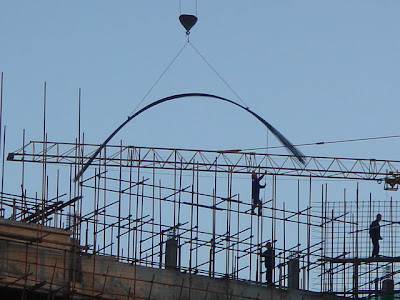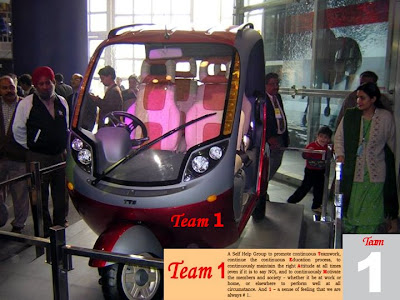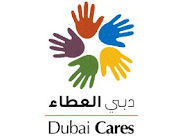Reliance Industries set to build L&T rival EPCIN 1988, Reliance Industries made a determined bid to take over Larsen & Tourbo, the country's premier engineering and infrastructure behemoth. But a fierce battle triggered by former prime minister VP Singh and the Indian Express group forced Reliance to retreat — one of the rare occasions when one of the country's most successful entrepreneurs Dhirubhai Ambani had to accept defeat.
Today, nearly two decades later, Reliance chairman Mukesh Ambani is all set to revive his father's plans of building an engineering, procurement and construction services (EPC) powerhouse, modelled on the same lines as one of L&T's core businesses. The blueprint for a separate global EPC business — which will bid for a variety of infrastructure projects within the country and overseas — has been on the drawing board for nearly three years.
But now, the building blocks are finally falling in place.
Like every project — be it in retail or upstream exploration — that Mr Ambani dreams up, this one too is no less gigantic. Back of the envelope calculations show that engineering and construction accounts for 75% of L&T's $5-billion turnover.
Reliance expects turnover of Rs 5,000 cr in first year RELIANCE expects that its new play will be able to gun for a turnover of Rs 5,000 crore in the first year itself, and double it in the second year. Reliance plans to execute its own projects as well as by building bridges, highways, dams, power projects, airports, chemical plants and refineries initially within the country and subsequently in the Middle East and the US.
The moorings When the plan was first mooted two years ago, the intent was much the same. Yet, as PMS Prasad, Reliance's CEO of its oil and gas business admits, building the mega refinery at Jamnagar became the dominant priority — and the task of building the competencies for a separate EPC play receded to the background.
In a small way, Reliance has already tested out the concept in the US through an initiative called Crest with US major Chevron. Across the western world and in the Middle East, almost all major petrochemical and refinery projects are running behind schedules, thereby leading to huge cost overruns. The reason: an alarming shortage of engineering talent. The idea behind the Chevron tie-up was to leverage Reliance's engineering design skills to ensure that these projects can be completed on time. So for about a year now, 70-80 engineers from Reliance have been working at Chevron's facilities in the US. "Chevron has an immediate requirement for 500 engineers. But we are finding it hard to supply that many," said a senior official at Reliance, on condition of anonymity.
With the Jamnagar refinery expected to be completed by March this year, Mr Prasad, who is leading the charge, is now making up for lost time. Nearly 700 engineers are already on board. More will be freed up as the Jamnagar project ends. The plan is to push up the headcount to 4,000-5,000 over the next two years.
Much like L&T which signed up joint ventures for separate verticals with global majors like Chiyoda of Japan and the US-based Sargent and Lundy, Reliance too is eyeing JVs to bring in global best practices on engineering process automation. In 2006, Reliance had signed a 50:50 engineering JV with Bechtel, the $20.5-billion US-headquartered engineering, procurement and construction firm to form BecRel Engineering.
Although Mr Prasad declined to comment, insiders said negotiations are on to form a separate JV with Bechtel for construction services. A formal decision is expected in the next couple of months. Much will depend on how serious Bechtel perceives Reliance to be about using its base in India for a gamut of engineering export services in Middle East. An email sent to Bechtel went unanswered.
Mr Ambani, though, is mighty serious, say insiders. As he sees it, the new plan is predicated on the country's strength as a high-quality, low-cost destination for global engineering, procurement and construction services.
But building overseas projects using engineering talent is easier said than done. One, tighter local immigration rules — among other things — will make it more difficult to send large teams of Indian workers to build dams and airports.
So Reliance is actually examining the option
of a unique onsite-offshoring model. So for instance, if it takes up the task of refurbishing many of the old refineries in the western world — and there are hundreds of such plants which Mr Prasad describes as 'paint held together by rust' — Reliance will look at sending small teams of engineers for either the finishing touches or testing and interconnecting, but bring back much of the fabrication work to its SEZ at Jamnagar, where it can modularise the construction at a relatively lower cost. Even if one were to add the cost of freight, Mr Prasad reckons there would be a sizeable cost savings for EPC projects in the Middle East.
Of course, the business model faces a huge challenge. The attrition rate is high among engineers. Already, many of those working for the $6-billion Jamnagar Export Refinery Projects are getting snapped up by other Indian and international firms. Reliance currently has 7,500 engineers working on the 27-milliontonne-per-annum Jamnagar refinery project.
It's a difficult challenge to retain them, when software firms coming calling. L&T chairman AM Naik has been a strong critic of software firms in India who continue to rely on engineers to fill up their ranks. As VV Bhat, Reliance's president, HR, admits, "We try our best to retain talent up to a certain limit. Beyond that we let them go. The engineers who will stay till the completion of the refinery project will get big money as part of their ESOPs. Most of them go to IT and other sectors." Even hiring engineers at the entry-level isn't easy. "Most engineers are taking up jobs in the financial, consulting services and IT because they pay more than double that of any engineering firm. Globally, only Schlumberger recruits in the petroleum sector. Margins are thin and most companies cannot compete with other sectors," said a senior academic at IIT Bombay.
So how does Reliance hope to cope with the staffing challenge? There are three routes that Reliance will take to staff its EPC business. One, it hopes to initially get a pool of experienced people through its collaborator. Two, it plans to offer an option for many of its experienced mid-career engineers in its operations, maintenance and technical functions, who want to seek a change. Three, it plans to continue hiring 700-800 engineers every year from engineering colleges across the country. The pitch: the sheer variety and hands-on experience of directly working in some of the biggest projects in the world — from building a retail and logistics supply chain to complex deep water exploration projects — and of course, a chance to also travel to other parts of the world. These trainees first get trained for six months to a year working on Reliance's own projects. And even though exact numbers are hard to get, billing rates are reckoned to be very hefty — making it far easier to pay a lot more to these engineers.
What it means for RelianceThere are very sound reasons why Reliance chairman Mukesh Ambani is excited by the opportunity of building an engineering services business. At one level, this enables him to harness Reliance's core competency of building large-scale projects at an aggressive pace and cost and institutionalise it for the future. For instance, when the Jamnagar project ends, Reliance will be able to put its engineers onto a new project — and thereby not lose them.
Secondly, when Reliance continues to execute many of its multi-billion dollar projects, it will not have to face serious quality and time delays that tend to take place now. "Many of our contractors find it incredibly difficult to find resources. But since we push them hard, they often use inexperienced people, who end up making mistakes. Our quality assurance teams invariably discover them and we are forced to redo the work, thereby slowing down the implementation," said Mr Prasad.
Finally, there's another critical reason and it is linked to Reliance's new-found accent on partnerships and inorganic growth. In the global M&A game, as Reliance sees it, having a robust EPC business is likely to be seen as a differentiator. Across the developed world, there is a huge shortage of engineering talent. So a partner who brings critical resources — the availability of low-cost, high quality engineering skills — to the table will gain the upper hand over, say, private equity firms.
RIL'S EPC PLAY
THE OPPORTUNITY Engg services for large projects like refineries or steel plants usually awarded as turnkey contract to one engg company. These lucrative contracts can either be for EPC or project mgmt contracts. Market for both these services is huge since there are only a few cos with the experience to handle such massive scale
THE ROUTE
RIL plans to tie up with a global engineering major like Bechtel and bid for large-scale infrastructure projects either by directly bidding for it and managing it or subcontracting it to domestic engineering firms like Punj Lloyd
Source:ET








































